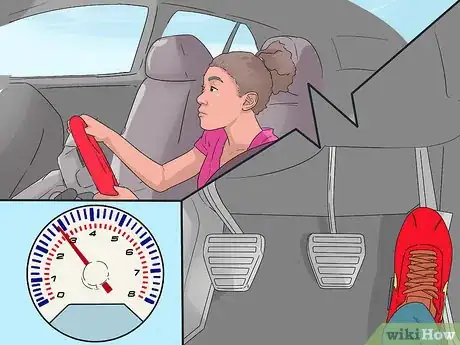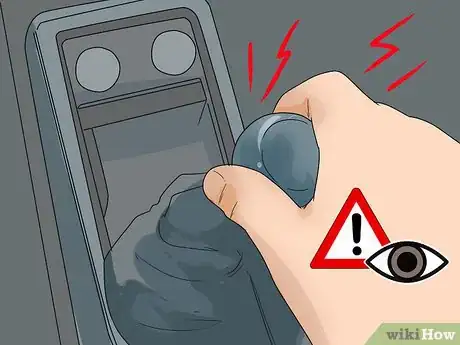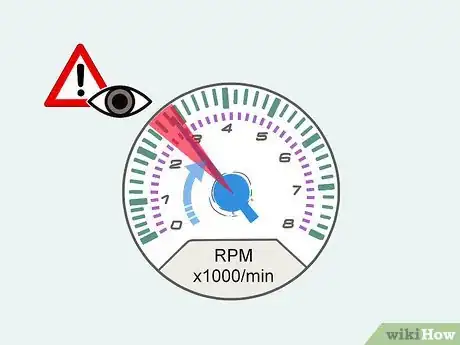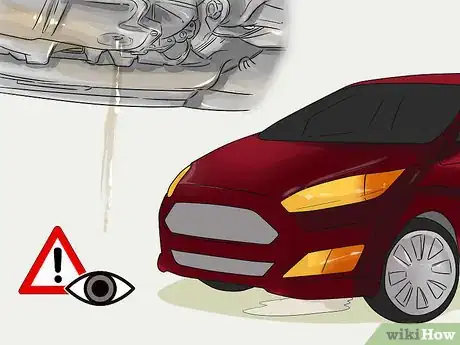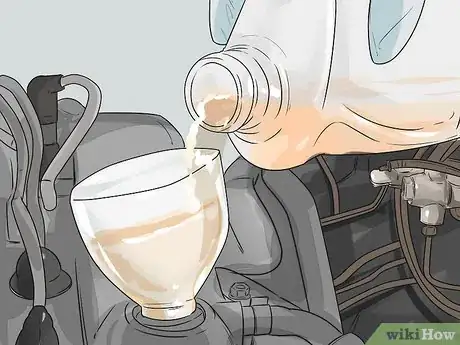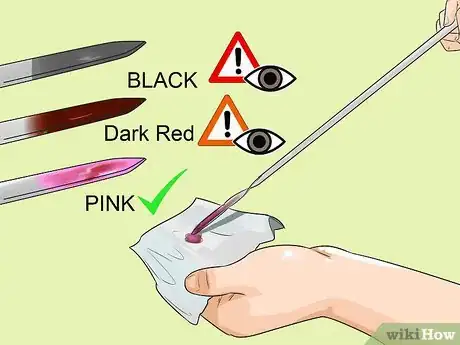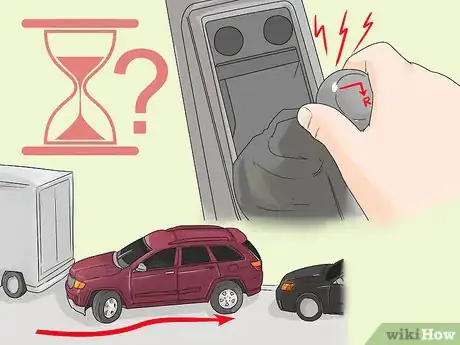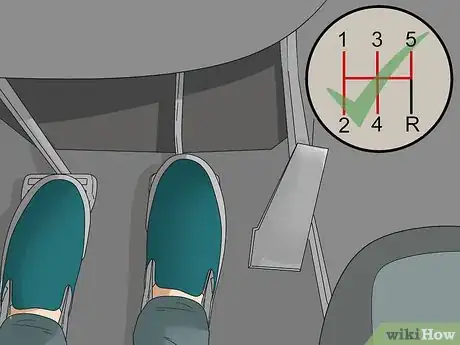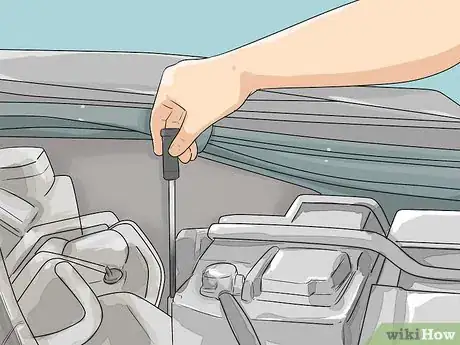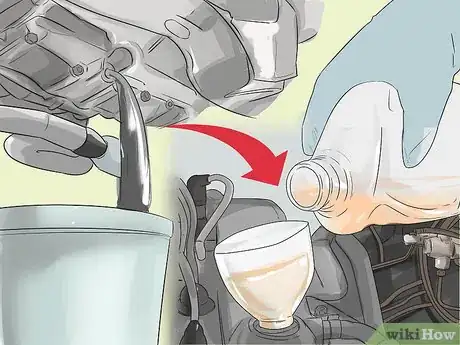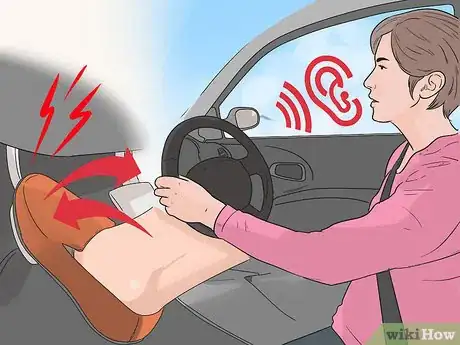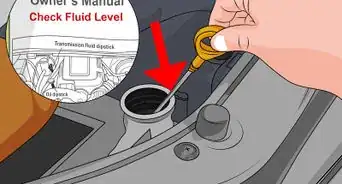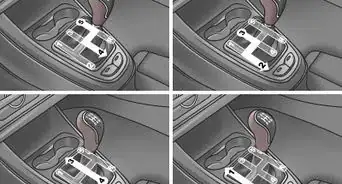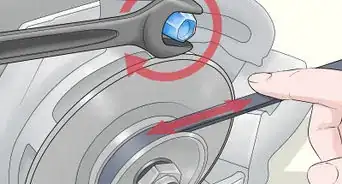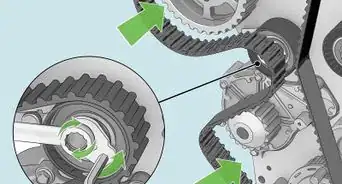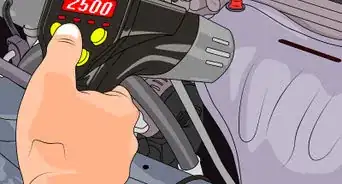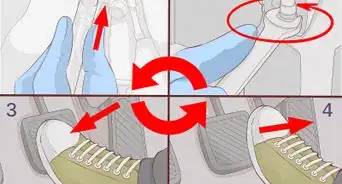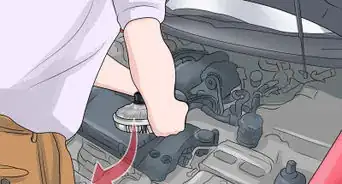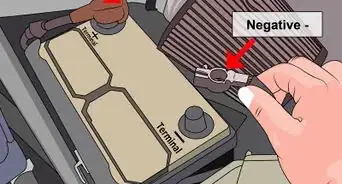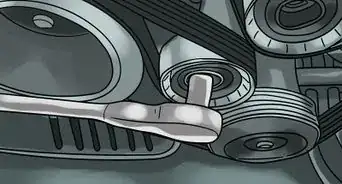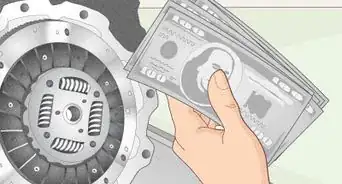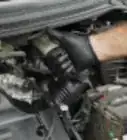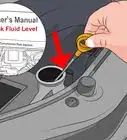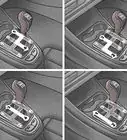This article was co-authored by Ed Beery. Ed Beery is an Automotive Specialist and the Owner of InTechgrity Automotive Excellence based in Denver, Colorado. With more than eight years of experience, he specializes in providing maintenance and repair services for both individuals and companies. Ed and the InTechgrity Automotive Excellence Team are approved by the American Automobile Association (AAA) for repairs and are Automotive Service Excellence (ASE) certified.
This article has been viewed 104,973 times.
Issues with your transmission can be difficult to diagnose and even more difficult to repair for the average hobby mechanic. Often, even professional repair facilities will replace a transmission rather than repair it due to the specialized skills and equipment required to service transmissions internally. Before you can assess your options for repair or replacement, you will need to identify the issue. While some transmission issues will be specific to certain years, makes, or models of vehicle, some things can be diagnosed fairly universally. Arm yourself with a diagnosis of your problem before seeking repair options to ensure you pay a fair price.
Steps
Troubleshooting Transmission Problems as You Drive
-
1Listen for grinding. Any time you hear grinding while driving your vehicle means trouble. Grinding while trying to put a manual transmission into or out of gear can be indicative of your clutch failing to engage or disengage completely or it may be a result of worn synchro gears in the transmission itself. If you hear grinding while in gear, it means there is metal caught in the gears of the transmission and it will likely fail very soon.[1]
- Pull the vehicle over immediately if you hear grinding while moving.
- You will need to have your vehicle towed home or to a repair facility.
- If the transmission grinds going into or out of certain gears, you can try double clutch shifting to get it through the gears without causing more damage.
-
2Pay close attention to vehicle vibrations. There are many things that can cause vibrations as you drive. While some may be as benign as a rock stuck in your tire or ice on your rims, others can indicate a serious issue with your transmission. If you hear or feel a new vibration as you drive, pull over and check your wheels and tires first. If they appear not to have any issues to speak of, the vibration is likely due to a problem with the drivetrain.[2]
- The drivetrain in your vehicle includes the engine, transmission, transfer cases and drive shafts.
- Try to get a sense of where in the vehicle the vibration is coming from.
Advertisement -
3Tie the vibration to engine speed or wheel speed. While driving and diagnosing a vibration, accelerate by pressing on the gas and assess whether or not the vibration speeds up, slows down or goes away. Now take the vehicle out of gear (in neutral) and press on the gas again. Determine if there is a difference between how the vibration acts in each instance. [3]
- If the vibration only occurs at certain speeds, it may be an unbalanced wheel.
- If the vibration goes away or stays constant while the vehicle is not in gear, it may be an issue with the wheels or drive shafts going to them.
- If the vibration increases with the RPMs of the engine, the issue is likely in the engine or transmission.
-
4Pay attention to jerky shifts. When driving a vehicle equipped with an automatic transmission, pay attention to the way it shifts from gear to gear. Automatic transmissions should shift fairly smoothly. If shifting feels abrupt or causes you to lurch forward, the transmission is struggling to shift into the next gear.[4]
-
5Watch the tachometer. Automatic transmissions are designed to shift at different RPMs based on the amount of throttle you input. If you are accelerating quickly (with the pedal to the floor) the transmission will shift at a higher RPM than under normal driving. That said, the transmission should not allow the vehicle to sit at a high RPM for long before shifting to the next gear. If it is, there is an issue.[7]
- You can usually hear when your car plateau’s at an RPM it should be shifting from.
- Listen for the sound of the engine working harder than it normally would as it stays in a lower gear for too long.
Diagnosing Common Automatic Transmission Problems
-
1Look for leaking transmission fluid. A common cause of issues with automatic transmissions is low fluid levels caused by leaks.[8] Look beneath your vehicle for wet spots. If you find one, touch it with your finger, then wipe your finger on a white sheet of paper to determine what kind of fluid it is by color.[9]
- Automatic transmission fluid is usually red, or dark red if it is old and has been burned.
- Coolant is usually green or orange.
- Oil is usually brown or black.
-
2Make sure the transmission fluid is full. If you have seen signs of leaking, check your transmission immediately by locating the dip stick for your transmission fluid. Much like an oil dipstick, there will be minimum and full lines clearly shown on the stick. Remove the dipstick and wipe it off, then re-insert it and remove it again to check the fluid levels. If the fluid level is low, adding transmission fluid may resolve the issue you’re having. [10]
- If you are unsure where to find the transmission fluid dipstick in your vehicle, refer to its owner’s manual for guidance.
- Check the transmission fluid levels even if there is no sign of leaking, just in case it was not filled completely when it was last serviced or if it has been burning fluid.
-
3Assess the state of the transmission fluid. Look at the fluid on the dipstick and assess the color.[11] Automatic transmission fluid is dark red in color, but it grows darker the longer it is in use. Dark color is not necessarily indicative of an issue unless it is nearly black in color and smells burnt. Conversely, if the color is extremely light or pink, it means water has gotten into the transmission fluid, which is also a serious problem. Draining and flushing your transmission fluid is not always a viable solution, but in some cases it is required.[12]
- Black or extremely dark red transmission fluid means the transmission has been operating at above its safe temperature range.
- Pink transmission fluid means there’s water in the fluid. You will need to drain the transmission and replace the fluid.
- The source of the water in your transmission fluid must be identified and repaired or it will occur again.
-
4Take note of how long it takes to shift out of park. With your foot on the brake, shift your vehicle out of park and into reverse or drive. While at a stop, shifting out of park should be nearly instantaneous. Count to yourself as you wait. If your count exceeds three seconds, the transmission is not operating the way it should. This may be indicative of over-worn or low transmission fluid.[13]
- Sluggish shifting, particularly into drive or reverse, often means the transmission fluid is too low or not performing properly.
- If the vehicle won’t shift out of park at all, it could mean that the transmission has internal issues and will need to be serviced or replaced.
Narrowing Down Issues with Manual Transmissions
-
1Ensure the transmission will shift into each gear. While stopped with the vehicle running, apply the parking brake and press the clutch pedal to the floor. Shift the transmission through each gear, starting with first and culminating with the highest gear your vehicle’s transmission is equipped with. It should shift into each gear smoothly and without any grinding or crunching.[14]
- If the vehicle cannot shift into any gears, your clutch may have failed.
- If you have issues shifting into a specific gear, it is likely the result of a failed synchro for that gear.
-
2Check the level of gear oil in the transmission. Manual transmissions are usually lubricated by gear oil instead of automatic transmission fluid (except in specific applications). Many manual transmissions have dipsticks similar to those found in automatic transmissions. Remove the dipstick and ensure the fluid level is correct.[15]
- If you are unable to find the dipstick on your transmission, refer to your owner’s manual for guidance.
- If you need to add gear oil, be sure to check your owner’s manual for the correct type of oil to add.
-
3Determine if the gear oil has been burnt. When checking the gear oil in your transmission, determining if it has been burned through overheating will be fairly easy. Burned gear oil has a powerful odor that may resemble onions. If the gear oil in your transmission is burned, it will making shifting more difficult and may lead to a breakdown of the components inside.[16]
- Burned gear oil will need to be drained and replaced.
- If the wrong gear oil is added, it may be more likely to burn and lead to mechanical failures. If the wrong oil has been added to your transmission, it will also need to be drained and replaced.
-
4Listen for sounds with the clutch pressed and de-pressed. If you hear a noise that seems to come from the transmission at an idle, press the clutch in and continue to listen. If the sound changes or stops, it is likely caused by a problem with the release or pilot bearing. Other common issues you may be able to diagnose by sound are:[17]
- A growling or grinding noises when the clutch is engaged likely means a problem with the transmission input shaft bearing.
- If you depress the clutch and hear a squealing sound, it is likely caused by a bad pilot bearing or bushing.
- A chirping sound that gets louder as you slowly depress the clutch pedal is likely caused by a faulty release bearing.
Expert Q&A
-
QuestionHow do you check transmission fluid?
 Ed BeeryEd Beery is an Automotive Specialist and the Owner of InTechgrity Automotive Excellence based in Denver, Colorado. With more than eight years of experience, he specializes in providing maintenance and repair services for both individuals and companies. Ed and the InTechgrity Automotive Excellence Team are approved by the American Automobile Association (AAA) for repairs and are Automotive Service Excellence (ASE) certified.
Ed BeeryEd Beery is an Automotive Specialist and the Owner of InTechgrity Automotive Excellence based in Denver, Colorado. With more than eight years of experience, he specializes in providing maintenance and repair services for both individuals and companies. Ed and the InTechgrity Automotive Excellence Team are approved by the American Automobile Association (AAA) for repairs and are Automotive Service Excellence (ASE) certified.
Automotive Specialist Low or dirty transmission fluid can be checked with most transmissions using the transmission fluid dipstick. Just keep in mind that some vehicles have closed systems without a transmission fluid dipstick.
Low or dirty transmission fluid can be checked with most transmissions using the transmission fluid dipstick. Just keep in mind that some vehicles have closed systems without a transmission fluid dipstick. -
QuestionWhat are some signs of transmission problems?
 Ed BeeryEd Beery is an Automotive Specialist and the Owner of InTechgrity Automotive Excellence based in Denver, Colorado. With more than eight years of experience, he specializes in providing maintenance and repair services for both individuals and companies. Ed and the InTechgrity Automotive Excellence Team are approved by the American Automobile Association (AAA) for repairs and are Automotive Service Excellence (ASE) certified.
Ed BeeryEd Beery is an Automotive Specialist and the Owner of InTechgrity Automotive Excellence based in Denver, Colorado. With more than eight years of experience, he specializes in providing maintenance and repair services for both individuals and companies. Ed and the InTechgrity Automotive Excellence Team are approved by the American Automobile Association (AAA) for repairs and are Automotive Service Excellence (ASE) certified.
Automotive Specialist Signs of transmission problems include hard shifting between gears or when moving the gear selector; the vehicle not going/having difficulty going into some gears; transmission fluid that puddles under the vehicle; a lurching vehicle; and/or the vehicle slipping in and out of gear under load (like going up a hill).
Signs of transmission problems include hard shifting between gears or when moving the gear selector; the vehicle not going/having difficulty going into some gears; transmission fluid that puddles under the vehicle; a lurching vehicle; and/or the vehicle slipping in and out of gear under load (like going up a hill). -
QuestionCan I repair a transmission myself?
 Ed BeeryEd Beery is an Automotive Specialist and the Owner of InTechgrity Automotive Excellence based in Denver, Colorado. With more than eight years of experience, he specializes in providing maintenance and repair services for both individuals and companies. Ed and the InTechgrity Automotive Excellence Team are approved by the American Automobile Association (AAA) for repairs and are Automotive Service Excellence (ASE) certified.
Ed BeeryEd Beery is an Automotive Specialist and the Owner of InTechgrity Automotive Excellence based in Denver, Colorado. With more than eight years of experience, he specializes in providing maintenance and repair services for both individuals and companies. Ed and the InTechgrity Automotive Excellence Team are approved by the American Automobile Association (AAA) for repairs and are Automotive Service Excellence (ASE) certified.
Automotive Specialist That's not a great idea unless you have a lot of automotive experience. Transmissions are specialty in the automotive world, and are one of the most complex systems on a vehicle.
That's not a great idea unless you have a lot of automotive experience. Transmissions are specialty in the automotive world, and are one of the most complex systems on a vehicle.
References
- ↑ http://www.firestonecompleteautocare.com/maintain/transmission/problems/
- ↑ http://www.firestonecompleteautocare.com/maintain/transmission/problems/
- ↑ http://www.firestonecompleteautocare.com/maintain/transmission/problems/
- ↑ https://mercedessource.com/problems/transmission/does-your-automatic-transmission-really-need-replacing
- ↑ Ed Beery. Automotive Specialist. Expert Interview. 19 November 2021.
- ↑ Ed Beery. Automotive Specialist. Expert Interview. 19 November 2021.
- ↑ https://mercedessource.com/problems/transmission/does-your-automatic-transmission-really-need-replacing
- ↑ Ed Beery. Automotive Specialist. Expert Interview. 19 November 2021.
- ↑ http://www.firestonecompleteautocare.com/maintain/transmission/problems/
- ↑ https://mercedessource.com/problems/transmission/does-your-automatic-transmission-really-need-replacing
- ↑ Ed Beery. Automotive Specialist. Expert Interview. 19 November 2021.
- ↑ http://www.agcoauto.com/content/news/p2_articleid/141
- ↑ https://mercedessource.com/problems/transmission/does-your-automatic-transmission-really-need-replacing
- ↑ https://mercedessource.com/problems/transmission/does-your-automatic-transmission-really-need-replacing
- ↑ http://www.aa1car.com/library/2004/ic20428.htm
- ↑ http://www.aa1car.com/library/2004/ic20428.htm
- ↑ http://www.aa1car.com/library/2004/ic20428.htm
About This Article
It can be stressful if your transmission is giving you problems, but with a bit of troubleshooting, you’ll be able to figure out what the issue is and how to repair it. If you have a manual vehicle and you hear grinding noises while driving, pull over immediately, since this means there is damaging metal caught in the transmission gears. You’ll likely want to get your car towed to a repair shop to prevent further damage. Another common transmission problem is leaks. If you notice any puddles beneath your car, check the transmission fluid dipstick and refill the fluids if it’s low. If your car takes a while to shift out of park into drive, this may also be a sign it’s low on fluids. Once you get to highway speeds, pay attention to see if your vehicle starts to vibrate. If the vibration increases with the RPMs of the engine, your transmission likely needs some work. To learn how to check your gear oil levels, read on.


